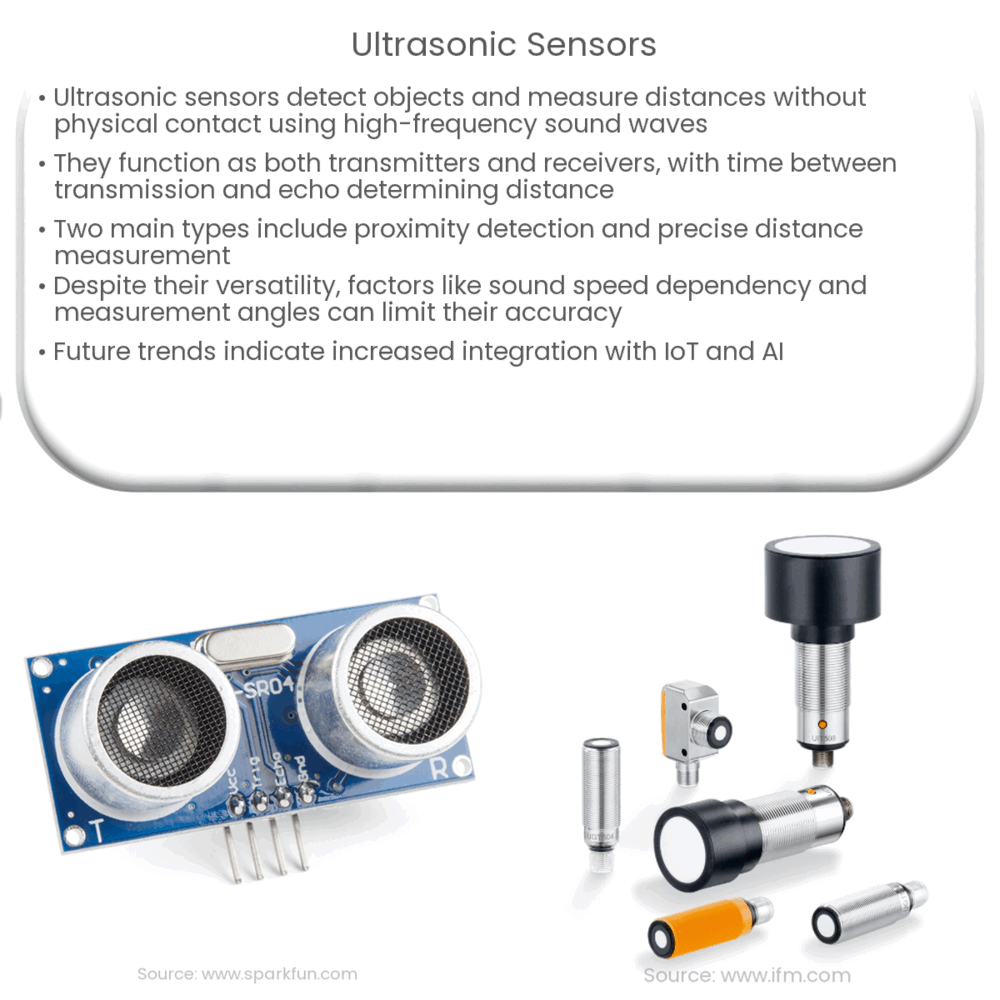Explore the workings, types, applications, advantages, and limitations of ultrasonic sensors, and discover their future trends in this comprehensive guide.

Introduction to Ultrasonic Sensors
Ultrasonic sensors are a type of sensor extensively utilized in various industries and fields due to their ability to measure and detect objects or distances without physical contact. These sensors use the principle of ultrasonic waves, high-frequency sound waves above the range of human hearing, typically starting around 20 kHz.
Working Principle of Ultrasonic Sensors
The operation of ultrasonic sensors revolves around the transmission and reception of ultrasonic waves. In essence, the sensor acts as both a transmitter and receiver. When it transmits ultrasonic waves towards a target object, it then waits for the waves to bounce back, essentially echoing from the object’s surface. The time elapsed from transmission to reception gives valuable data about the distance to the target.
- Transmitter: The transmitter component of an ultrasonic sensor generates ultrasonic sound waves. The process involves an electrical signal being converted into a mechanical movement, creating the necessary vibrations to produce the sound waves.
- Receiver: The receiver of the sensor detects the ultrasonic waves that bounce back from the object. The mechanical vibrations of the returning waves are converted back into an electrical signal that can be processed and interpreted.
Types of Ultrasonic Sensors
There are mainly two types of ultrasonic sensors available, differentiated based on their mode of operation:
- Proximity Detection: These sensors work based on the presence or absence of an object within a specified range. They are used in applications where the precise distance measurement is not needed, but rather a binary detection of “object present” or “object absent”.
- Distance Measurement: These ultrasonic sensors provide specific distance measurements to the object. They are often used in applications where precise and accurate distance measurements are crucial, such as in robotics or industrial automation.
Applications of Ultrasonic Sensors
Ultrasonic sensors find extensive use across various domains and industries, thanks to their reliable, non-contact measurement capabilities. A few notable applications include:
- Automotive Industry: In the automotive industry, ultrasonic sensors are often used in parking assistance systems to detect objects and measure the distance from the vehicle.
- Industrial Automation: These sensors play a vital role in controlling and monitoring processes in automation industries.
- Healthcare: Ultrasonic sensors are used in various healthcare equipment, most notably in ultrasound imaging systems.
Each of these applications leverages the unique advantages of ultrasonic sensors to enhance their functionality and reliability. The next part will delve into the advantages and limitations of these sensors, along with exploring future trends.
Advantages and Limitations of Ultrasonic Sensors
Ultrasonic sensors come with several distinct advantages that make them an ideal choice for a range of applications:
- Non-Contact Measurement: These sensors can measure or detect objects without needing to make any physical contact, which is especially useful in conditions where contact measurement methods could damage the object or the sensor.
- Material Independent: Ultrasonic sensors can measure any type of object, regardless of its color, transparency, or surface properties. This makes them versatile and suitable for a wide array of applications.
- Environmentally Resilient: They function effectively even in harsh conditions such as dust, mist, or smoke, where optical sensors might struggle.
Despite these advantages, ultrasonic sensors also have some limitations:
- Speed of Sound Dependency: Since ultrasonic sensors rely on sound waves, their accuracy is dependent on the speed of sound, which can vary with environmental factors like temperature and humidity.
- Limited Range: Ultrasonic sensors have a limited range and might not function optimally for very long-distance measurements.
- Angle of Measurement: They are less effective when trying to measure the distance of an object that is not perpendicular to the sensor, as the sound waves may not reflect back directly.
Future Trends in Ultrasonic Sensors
As technology evolves, we can expect ultrasonic sensors to become even more integrated into our lives. Developments in IoT (Internet of Things) and AI (Artificial Intelligence) will likely open up new applications and uses for these sensors. Additionally, ongoing advancements in miniaturization and energy efficiency are set to make these sensors even more versatile and user-friendly.
Conclusion
In conclusion, ultrasonic sensors offer a reliable, non-contact method for object detection and distance measurement, suitable for various applications across numerous industries. Despite some limitations, their versatility and adaptability to different environments make them a valuable tool in our technological toolkit. As we continue to innovate and advance technologically, the role and importance of ultrasonic sensors are expected to grow, making them an exciting field to watch in the years to come.

